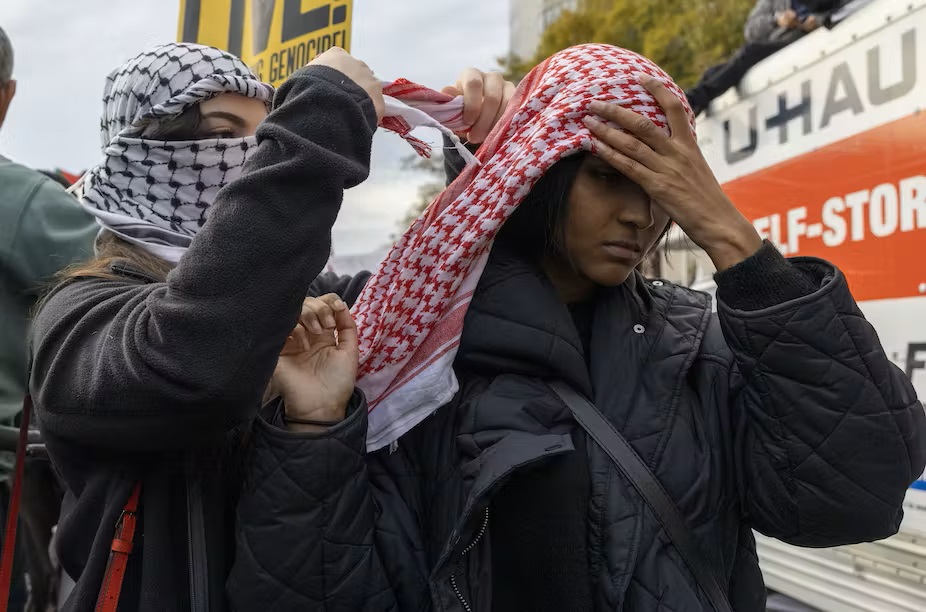The Keffiyeh – A Symbol Of Palestinian Identity
Dec 5, 2023 | Pratirodh Bureau
Two people use a Palestinian keffiyeh to show their support during a pro-Palestinian demonstration in Washington on Nov. 4, 2023 (AP Photo/Amanda Andrade-Rhoades)
After Israel declared war on Hamas following the militant group’s surprise attack on Oct. 7, 2023, and hostilities resumed in the region, some Palestinians have been urging non-Palestinians to wear the keffiyeh, a distinctive checkered scarf, during protests.
Indeed, several Palestinian diaspora communities and their allies across the globe have taken to wearing the keffiyeh as a mark of solidarity. Last week, three Palestinian students who were shot in Vermont were wearing black-and-white keffiyeh scarves.
As a scholar of immigrant communities and religious minorities in Europe, I am aware of the history that shaped the keffiyeh’s origins and its transformation as a symbol of Palestinian cultural and national identity.
Use Across Diverse Cultures
The keffiyeh has deep roots that stretch back centuries in the arid landscapes of the Middle East. Traditionally crafted from cotton, it was first donned by the nomadic Bedouin tribes as a protection against the desert sun and sand.
The keffiyeh’s usefulness in the desert landscape played a key role in its widespread popularity across diverse cultures in the region. At the turn of the 20th century, both Jewish and Arab communities wore the keffiyeh.
Many Jews who moved to Ottoman- and British-controlled Palestine chose to wear the keffiyeh because they saw it as part of the authentic local lifestyle.
A Symbol Of Palestinian Identity
Apart from its practicality, the keffiyeh also emerged as a symbol of class struggle. While rural farmers wore the keffiyeh, the Palestinian middle and upper class embraced the fez. Also known as “tarboush,” the fez is a traditional brimless hat popularized by the Ottomans, typically made of felt and adorned with a tassel.
The fez was made popular in the 1800s by the region’s former ruler, Ottoman Emperor Mahmud II. The Palestinian elite adapted these Ottoman-style hats as a standard form of dress.
In the 1930s, the keffiyeh underwent a second transformation. During the revolt against the British, who took over Palestine from the Ottoman Empire after the First World War, the keffiyeh became a distinctive national symbol that united all Palestinians and replaced the fez.
Some rebels strategically donned the keffiyeh to hide their faces, as a way to avoid potential repercussions from British authorities.
It underwent another transformation following the establishment of the state of Israel in 1948. After the displacement of hundreds of thousands of Palestinians during the 1948 Arab-Israeli war, the keffiyeh became an expression of Palestinian resilience against Israel’s treatment of Palestinians. Worn by both those who were displaced and those who remained, the headdress captured the emotional connection to the land.
The keffiyeh’s prominence soared notably in the 1970s when Yasser Arafat, leader of the Palestine Liberation Organization, a Palestinian nationalist movement, adopted and popularized the garment. Arafat’s distinctive style, featuring the keffiyeh draped over his head and shoulders, became synonymous with the Palestinian cause. In 1974, he addressed the United Nations while wearing the keffiyeh.
The keffiyeh has even been addressed in news headlines as “the unofficial flag of Palestine,” and Palestinian communities globally mark a World Keffiyeh Day on May 11. It has become popular among Palestinian militant groups as well as Palestinian rights activists.
In recent years, influential cultural figures such as Palestinian singer and 2013 “Arab Idol” winner Mohammed Assaf have contributed to the further popularization of the keffiyeh.
Symbol Of Solidarity
The keffiyeh’s resonance has not been confined to the West Bank and Gaza Strip. As images of Palestinian protests and resistance spread globally, so did the symbol of the keffiyeh. Activists and supporters around the world adopted the keffiyeh as a gesture of solidarity with the Palestinian cause.
The fashion industry has played an important role in spreading the keffiyeh globally. Its typical design with the fishing net and olive leaf engravings symbolizing the Palestinian economy has found its way onto various clothing items, ranging from scarves to shirts. However, these items often lack the political context that defines the keffiyeh’s importance for Palestinians.
Its promotion as a fashion accessory and the appropriation of its checkered design by some leading fashion brands have sparked debates about the importance of respecting the political and historical context of the keffiyeh. At the same time, keffiyeh manufacturers in the Palestinian territories are also facing increasing competition from factories in China.
Despite these challenges, the keffiyeh continues to be worn by Palestinians and supporters worldwide.
(Published under Creative Commons from The Conversation. Read the original article here)
